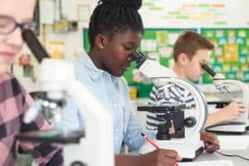Inherited Traits Inquiry Lab
Middle School Inquiry Lab on Inherited Traits
In this lab students will design a model of a DNA strand representing one gene. They will make a flowchart of a gene, DNA, chromosome, nucleus, and cell so that they understand where genetic material is found.
Each inquiry lab will contain an essential question that will drive the lesson and make students think. For this lesson, the essential question is:
- How are individual traits determined by DNA? What is the structure of DNA, and where is it found?
BACKGROUND INFORMATION AND MATERIALS LIST:
Students will begin the lab by reading the essential question and background information. This can be done individually, as lab groups, or as a whole class. If you consider lab groups, you also might include some type of whole class formative checks before digging into the lab.

Materials List:
- red Twizzlers candy (2 pieces to represent the strands)
- several miniature marshmallows (at least 12 in 4 colors to represent the bases)
- toothpicks (6-8 to represent the bonds)
- trait chart (1 per person)
PROCEDURE:
For this lab, there are three portions that students will need to complete.
In the first part, students will go around the class making tally marks on their lab sheet, identifying certain traits that their classmates have. In the second part, students get to build a section of a gene by using the Twizzlers, marshmallows, and toothpicks. Students will have to follow the directions indicating which colored base pair of marshmallows that are required is in the construction. Finally, students will label the illustration showing the correct order of level of organization from cell to gene.
Option: Instead of having students walk around taking a tally, you can ask the class as a whole and then record the data on the lab sheet. This will allow time to complete the lab within one class period. You will have to decide whether or not students will be able to eat the model when the lab is complete.
CHECK FOR UNDERSTANDING:
At this point in the lab, students will be checked for understanding by answering questions about their findings. Here are a few that come with the lab:
- How does the frequency of certain traits relate to traits being passed down from parents?
- Would the traits passed down from these two genes be the same, or different? Why?
CONCLUSION
Students will go back to the essential question and write a CER (Claim, Evidence, Reasoning) to conclude the lab. Once completed, students will reflect back on their learning by answering the following questions:
- What genetic trait of your classmates was the most common? Do you think this would be true in other classes?
- Based on what you have learned about genetic material, why do you think everyone in your class looks different?
- Draw a conclusion about the genetic makeup of identical twins.
MODIFIED AND INDEPENDENT INQUIRY VERSIONS
All of the Kesler Science inquiry labs come with three different modification levels. Each lab is differentiated using the icons below.
STANDARDS ALIGNMENT
TEKS: 7.14C – Recognize that inherited traits of individuals are governed in the genetic material found in the genes within chromosomes in the nucleus.

Download Over $100 in FREE Resources
For Middle School Science
Simply create a login below and gain immediate access to a selection of our Kesler Science product line worth $100 - for FREE. There's a full version of every product type! You'll also join tens of thousands of middle school science teachers who receive timely tips and strategies straight to their inbox.





